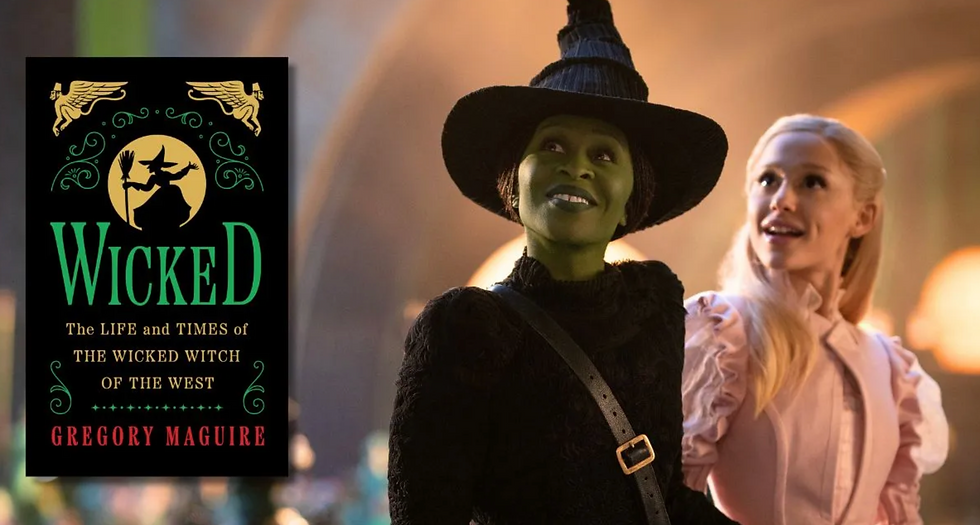Bringing Oz to Life: How the Movie Wicked Reinterprets Gregory Maguire’s Novel
- Odett Terrazas
- Jan 8
- 3 min read
When Gregory Maguire’s Wicked: The Life and Times of the Wicked Witch of the West first hit shelves in 1995, it redefined the world of Oz as a morally complex, deeply political landscape. Decades later, Wicked has enchanted yet another audience with its film adaptation.
While both mediums explore the story of Elphaba, the misunderstood Wicked Witch of the West, they approach her journey from distinct angles. Each offers a unique interpretation of her character, the world she inhabits, and the themes that define her tale.

Elphaba: A Witch for the Screen
In Maguire’s novel, Elphaba’s greenness serves as a metaphor for otherness, and her sharp wit and strong convictions make her as intimidating as she is endearing. Born with green skin and a full set of sharp teeth, Elphaba is an object of fear and fascination from the moment she enters the world. Even in her infancy, she is seen as dangerous, alien, and a source of shame for her family.
As she grows older, Elphaba’s intelligence and independence further distance her from those around her. Her unwillingness to succumb to the rule of Oz, particularly her opposition to the Wizard’s oppressive regime, brands her as an antagonist in their world.
While the book often lets readers wrestle with whether Elphaba is truly “wicked,” the film leans into her humanity and positions her as a sympathetic protagonist from the start. They softened Elphaba’s edges, framing her more explicitly as a tragic hero. This change allows the film to connect with a broader audience but at the expense of some of the moral ambiguity that made her character so compelling in the novel.
Oz: A Different Landscape
The Wicked musical features a striking dragon set piece hanging above the stage, and is animated during the show's opening. In the movie, Ariana Grande’s Glinda references the Time Dragon in its opening sequence, in reference to the Wicked Witch’s death. In Gregory Maguire’s novel, however, the Clock of the Time Dragon is a pivotal element. It’s not only a complex feat of machinery, but a traveling puppet theater that predicts the future, leading to the formation of a cult. This religion becomes a source of tension, as Elphaba’s father, Frexspar, strongly disapproves of it but Elphaba herself is born inside the Time Dragon.
While the book uses the Time Dragon for its commentary on belief systems and power struggles, the movie shifts its focus. The film’s Emerald City gleams with its towering spires and intricate sets. To bring this fantastical land to life, the filmmakers built everything in scrutinous detail of the original Wizard of Oz movie and Maguire’s descriptions. They even planted 9 million tulips to craft the vibrant landscapes of Munchkinland. This attention to detail draws viewers into the wonder of Oz, creating a spectacle that feels alive and tangible. However, while these aesthetics captivate audiences, they inevitably replace the story’s layered commentary with a more visually-driven narrative.
Themes Reimagined
At its heart, Maguire’s Wicked delves deeply into the complexities of power, morality, and identity, often leaving readers in morally ambiguous territory. It’s nuanced exploration of these themes forces readers to question the nature of good and evil, especially as Elphaba herself is often misunderstood or vilified for actions rooted in justice.
The movie, however, simplifies these moral quandaries to meet the emotional and visual demands of film. Elphaba’s relationships, particularly her bond with Glinda and Madame Morrible, become central to the narrative so as to offer an easily digestible tale of empowerment, catering to the expectations of a blockbuster audience.
The Wicked film adaptation reimagines Maguire’s novel in ways that highlight the unique strengths and limitations of cinema. While the book invites readers to confront uncomfortable truths about power, morality, and prejudice, drawing clear parallels to our world, the film leans into the dazzling spectacle of a fantastical Oz. Interestingly, the movie also uses desaturation in its color palette to ground parts of Oz in a more subdued reality, creating a visual contrast between the magical elements and the harsher undertones of its story. This immersive visual experience distances the narrative from reality through its grandeur, offering escapism while subtly nodding to the real-world struggles reflected in Oz’s societal divisions.
It challenges us to question the labels we assign to others and to consider the systemic forces that shape perceptions of good and evil. They show that whether we’re grappling with the complexities of our world or losing ourselves in the magic of another, every story carries lessons that resonate beyond its pages or screen.




What a fascinating comparison! It's always intriguing to see how adaptations like Wicked shift perspectives between book and screen. Elphaba’s transformation from misunderstood character in the novel to a more sympathetic, empowering figure in the movie is especially powerful. It reminds me how reinterpretation can breathe new life into stories. On a different note—if anyone’s juggling studies or exams while diving into Oz, here's a helpful resource to ease the load: Take My HESI Exam For Me. Balance is everything!
Escape into the ultimate getaway with Centaur Hotel Escorts. Their ability to entice and their captivating nature ensures every experience is as enjoyable as it is satisfying, ideal for the discerning gentleman.
paladin mining…
paladin mining…
savvy mining…
crypto mining…
cesur mining…
six mining…
advanced miners…
stainless steel…
Stainless Steel…
蜘蛛池搭建 蜘蛛池搭建
paladin mining…
paladin mining…
savvy mining…
crypto mining…
cesur mining…
six mining…
advanced miners…
stainless steel…
Stainless Steel…
蜘蛛池搭建 蜘蛛池搭建
paladin mining…
paladin mining…
savvy mining…
crypto mining…
cesur mining…
six mining…
advanced miners…
stainless steel…
Stainless Steel…
蜘蛛池搭建 蜘蛛池搭建